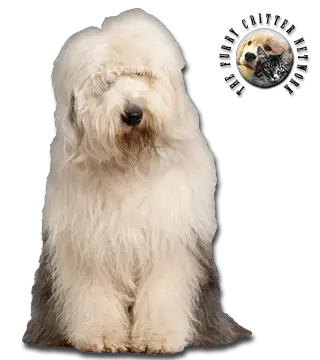Breed Standard
Head: Strong and blocky. Capacious skull. Well-defined stop. Square, strong, truncated muzzle. Large nose.
Ears: Small, carried flat against the head.
Eyes: Wide-set. Dark color or walleye. Blue eyes are acceptable.
Body: Short and compact. Deep, full chest with well-sprung ribs. Shoulders well laid back. Legs with plenty of bone. Withers lower than the loin. Gently arched, stout loin. strong neck.
Tail: OESed or docked.
Hair: Profuse, hard texture, shaggy, free from curl. Thicker on the hindquarters than on the rest of the body. Soft, dense undercoat.
Coat: Any shade of gray, grizzle, or blue. The body and hindquarters are of uniform color, with or without small white markings on the feet (socks). The head, neck, legs, and underbody must be white. Any brown markings are faults.
Size: Dog: minimum of 61 cm. (24 in).Bitch: minimum of 56 cm. (22 in).
Weight: 25 to 30 kg (55-66 lb).
History
The OES comes from the very old pastoral type dogs of England, but no records were kept of the dogs, and everything about the earliest types is guesswork. A small drop-eared dog seen in a 1771 painting by Gainsborough is believed by some to represent the early type of the OES. In the early 19th century a OESed drovers dog, called the Smithfield or Cotswold Cor, was noticed in the southwestern counties of England and may have been an ancestor. Most fanciers agree that the Bearded Collie was among the original stock used in developing today's breed. Some speculate that the Russian Owtchar was among the breed's ancestors.
The OES was at first called the "Shepherd's Dog" and was exhibited for the first time at a show in Birmingham, England, in 1873. There were only three entries, and the judge felt the quality of the dogs was so poor that he offered only a second placing. From that beginning, the breed became a popular show dog, and, although the shape of dog itself has changed very little over the years, elaborate grooming including backcombing and powdering the fur were recorded as early as 1907. The breed was exported to the United States in the 1880s, and by the turn of the 20th century, five of the ten wealthiest American families bred and showed the OES. The breed continues to be a popular show dog today.
Behavior
They are a vigorous, playful animal. He is neither fearful nor aggressive. This affectionate breed is calm and even-tempered. Nicknamed the "nanny dog," he always looks out for the children. Though he has the heart of a guardian, he is not aggressive and will not bite. Besides, with his teddy bear appearance and "pot-casse" bark, he does not look particularly threatening.
They can adapt to city life in an apartment if he is always with his owner and can have time to run each day. He does not bear the heat well. This intelligent dog has a mind of his own, and therefore needs firm training. Daily brushing is very important to keep his profuse, shaggy coat from knotting.
Function
Sheepdog (now rarely used as a sheepdog), Pet.
Health
The Old English Sheepdog Club of America sponsors investigations into diseases encountered in the breed in order to assist breeders in selecting healthy dogs for breeding, and breeders of Old English Sheepdogs who are members of the Old English Sheepdog Club of America must support its Code of Ethics in breeding and selling sheepdogs. Some diseases being investigated include hip dysplasia, cataracts, glaucoma, entropion, thyroid problems, deafness, diabetes, HD, PRA, allergies and skin problems. There is no data on how many dogs are affected, or what percent of the breed is affected by any of these ailments. Heatstroke is also a serious concern in full coated dogs. Cancer is a major cause of death amongst Old English Sheepdogs.






